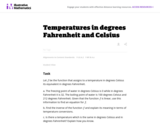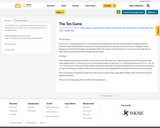
Use simple materials to explore the use of lenses and telescopes.
- Subject:
- Science
- Material Type:
- Activity/Lab
- Provider:
- EU-UNAWE Spain
- Provider Set:
- EU Universe Awareness
- Date Added:
- 05/10/2018

Use simple materials to explore the use of lenses and telescopes.

This manual provides an overview of how telescopes have changed our understanding of the universe and contains simple demonstrations to use at star parties to get across basic ideas of optics. This manual will also help explain why the images that folks see at the eyepiece of a telescope at an outreach star party is so different from images published in magazines. The manual was produced to accompany an outreach toolkit developed for the NASA Night Sky Network. The toolkit is no longer being manufactured, but the activities are available through the manual, which can be freely downloaded.

Telescopic Text allows you to unfold words and phrases to reveal more details.

This short video and interactive assessment activity is designed to teach third graders an overview of before and after (time).

This short video and interactive assessment activity is designed to teach second graders an overview of before and after (time).

Writers and film buffs alike will sharpen their skills in this multimedia unit as they work together to author and design a digital video.

Students tell their life stories in this lesson about autobiographies based on family photographs.

In this task students are given graphs of quantities related to weather. The purpose of the task is to show that graphs are more than a collection of coordinate points, that they can tell a story about the variables that are involved and together they can paint a very complete picture of a situation, in this case the weather.

Students use pitch to explore the characters in a story.

This short video and interactive assessment activity is designed to teach fourth graders about telling the time - before and after.

In this problem-based learning activity, students are asked to research and make recommendations that balance the benefits of a healthy forest with the economic needs of the people who log it. Students use NIH Image software to analyze satellite imagery from Landsat. This activity is from Exploring the Environment.

These unit conversion problems provide a rich source of examples both for composition of functions (when several successive conversions are required) and inverses (units can always be converted in either of two directions).

Students are introduced to the health risks caused by cooking and heating with inefficient cook stoves inside homes, a common practice in rural developing communities. Students simulate the cook stove scenario and use the engineering design process, including iterative trials, to increase warmth inside a building while reducing air quality problems. Students then collect and graph data, and analyze their findings.

In this activity, student teams design and conduct a scientific investigation in which they explore the conditions necessary for life. They conduct observations of environmental conditions both indoor and outdoor, and determine the range of variation they see. They compare these data with published temperature data for Earth, Mars, Pluto and Venus. The activity supports inquiry into the real world challenge of searching for life in extreme environments. The resource includes several student data sheets, data table and images, and a teacher's guide. Materials needed for this activity include weather instruments (e.g., thermometers, barometers, anemometers). This is Activity A of two activities in the first module, titled "Temperature variations and habitability," of the resource, "Earth Climate Course: What Determines a Planet's Climate?" The course aims to help students to develop an understanding of our environment as a system of human and natural processes that result in changes that occur over various space and time scales.

In this activity, student teams create a knowledge map of the essential characteristics or factors of a planet with a habitable climate, identifying range of inputs, outputs and variables of a planetary environmental system. Identified characteristics are compared to extreme environments on Earth, such as the Antarctic or the Sahara desert, and are used to consider the real life challenge of searching for life in extreme environments. The resource includes a student data sheet, questions, teacher's guide and scoring rubric. This is Activity B of two activities in the first module, titled "Temperature variations and habitability," of the resource, Earth Climate Course: What Determines a Planet's Climate? The course aims to help students to develop an understanding of our environment as a system of human and natural processes that result in changes that occur over various space and time scales.

Temperature conversions provide a rich source of linear functions which are encountered not only in science but also in our every day lives when we travel abroad. The first part of this task provides an opportunity to construct a linear function given two input-output pairs. The second part investigates the inverse of a linear function while the third part requires reasoning about quantities and/or solving a linear equation.

Students examine graphical and tabular data to determine whether the evidence suggests that becomes COå_ concentrations and temperature rise can be linked causally. The resource provides graphs and tabular data for student investigation and a student worksheet. This is an activity from Space Update, a collection of resources and activities provided to teach about Earth and space. Summary background information, data and images supporting the activity are available on the Earth Update data site.

This art history video discussion examines the Temple of Portunus (formerly known as, Fortuna Virilis), travertine, tufa, and stucco, c. 120-80 B.C.E., Rome.

These word problems about money require students to think in base 10.

The “Ten Game “ is a counting game that uses predictive and reasoning skills. It is applicable for most grade levels and can be adapted easily.